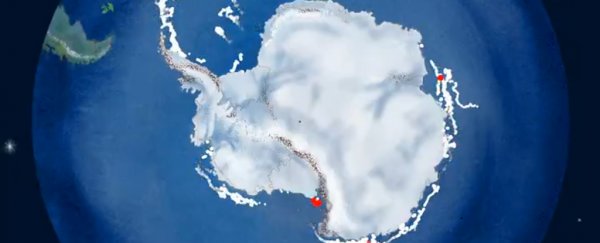We know that huge chunks of ice are breaking off Antarctica at an alarming rate, but sometimes a smart visualisation is what it takes to really understand the scale of a problem – and that's exactly what we've just got for Antarctic icebergs over the last 40 years.
Science animators Pixel Movers & Makers (Marlo Garnsworthy and Kevin Pluck) have put together a 50-second clip showing iceberg movement from 1976 to 2017, and it really drives home how much ice has gone wandering.
Check out the video below:
We've been looking forward to making this!
— Pixel Movers & Makers (@PixelMnM) November 11, 2018
Iceberg flux from Antarctica from 1976-2017.
Most icebergs travel counter-clockwise around Antarctica before travelling north through "Iceberg Alley" to the ACC.#Antarctica #iceberg #glacier #IcebergAlley @kevpluck @MarloWordyBird pic.twitter.com/MTY0jZMSxv
In particular, it highlights the collapse of the Larsen B ice shelf in 2002, and the journey of B-15 – with a surface area of around 11,000 square kilometres (roughly 4,250 square miles), it's the biggest recorded iceberg in history, and it detached itself from Antarctica in March 2000.
"I was surprised and yet not to see an apparent uptick in iceberg flux in recent years," Garnsworthy told Brian Kahn at Earther. "Certainly, the calving and breakup of B-15 and the collapse of Larsen B ice shelf in 2002 are pretty spectacular."
The data used to make the visualisation was gathered from a variety of sources and agencies, including the Center for Remote Sensing at Brigham Young University (BYU) in Utah, the NASA Jet Propulsion Laboratory, and the European Space Agency.
One of the sources of information was the the Antarctic Iceberg Tracking Database managed by BYU, which pulls together data from six satellites carrying scatterometers – instruments that track objects on Earth's surface by their reflected energy.
The icebergs included in the finished video are those large enough to be tracked by these scatterometers. Particularly big bergs get the honour of being officially named – like B-15 – in part so that ships can avoid them.
As you can see from the animation, once icebergs are detached from the Antarctic glacier, then tend to travel in an anti-clockwise direction, before heading down "Iceberg Alley" to the Antarctic Circumpolar Current that circles the frozen continent.
At that point the icebergs are at the mercy of the ocean winds and currents, and will eventually melt and return to the oceans as water.
Garnsworthy and Pluck say they were spurred into creating the animation while preparing an expedition into Iceberg Alley next March. Impressively, they managed to pull the whole animation together over the course of a weekend.
"Thankfully the data was in good shape and didn't require any conversions so I could start rendering it almost straight away," Pluck told ScienceAlert. "We were also in discussion with Antarctic scientists who suggested we highlight the calving of B-15 and the Larsen B break up."
"That truly showed the dynamic nature of icebergs and their longevity."
The huge size of Antarctica means scientists have only really been able to get a proper look at it with the arrival of satellite technology in the 1970s. As a result it's difficult to determine how much of this iceberg action is directly related to global warming.
What does seem clear is that the rate of ice loss on the continent is speeding up – more than three trillion tons of the stuff have gone since 1992, and 40 percent of that loss occurred between 2012 and 2017.
Huge icebergs continue to become detached from Antarctica, which in turn allows the ice behind them to flow more easily into the oceans, which in turn contributes to sea level rise. If Antarctica completely melted, estimates show, global sea levels could rise by more than 50 metres (164 feet).
Now the race is on to understand more about why and how Antarctica is losing ice, and what we can do to control rising temperatures in the region.
Let's hope data visualisations, like the iceberg tracker history put together by Pixel Movers & Makers, can help keep the changing face of the planet in the public consciousness.
